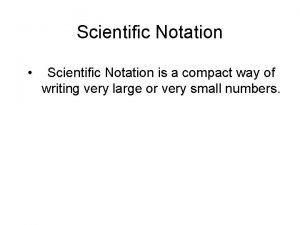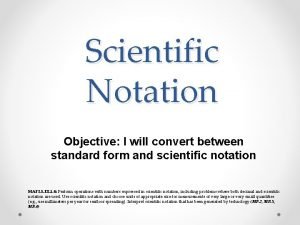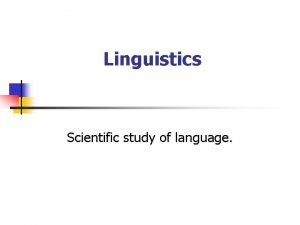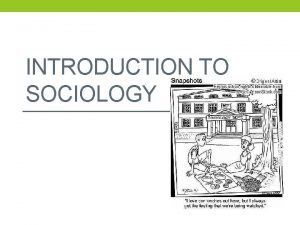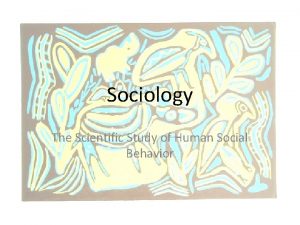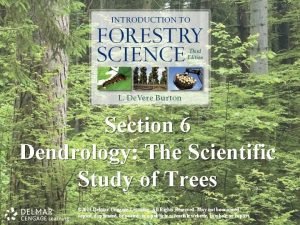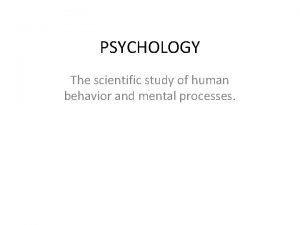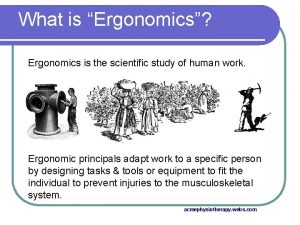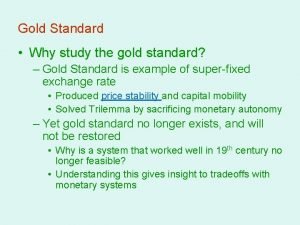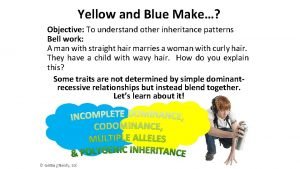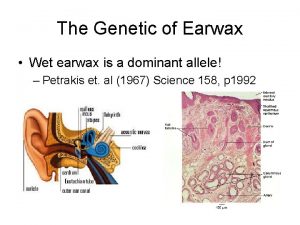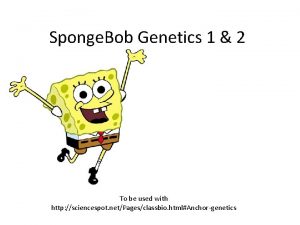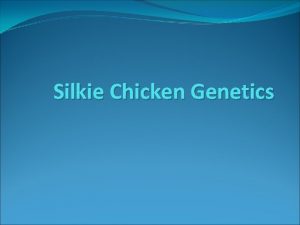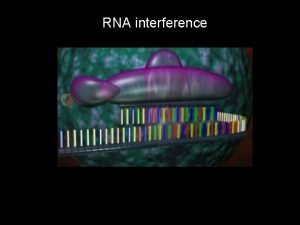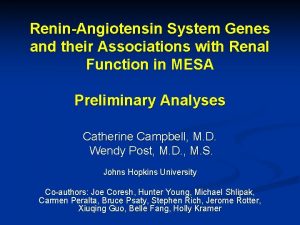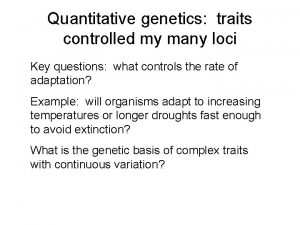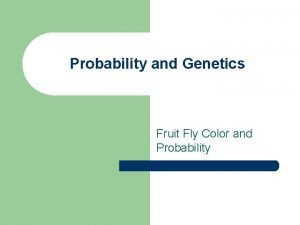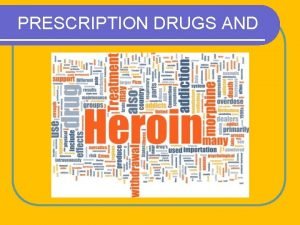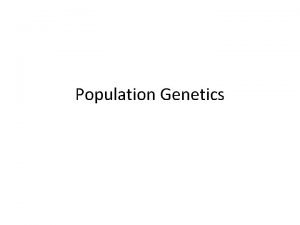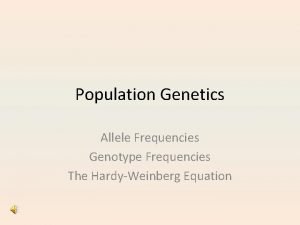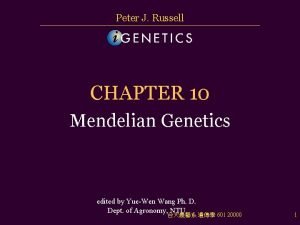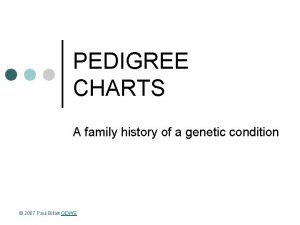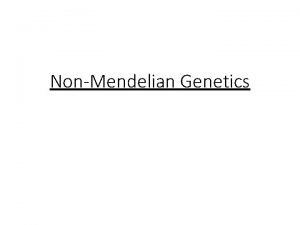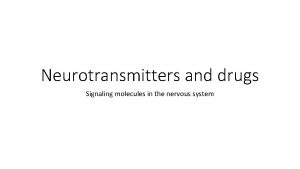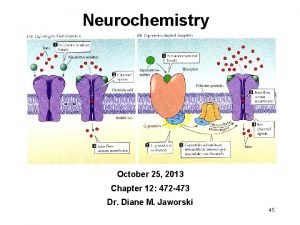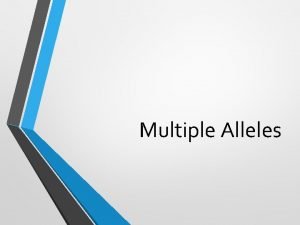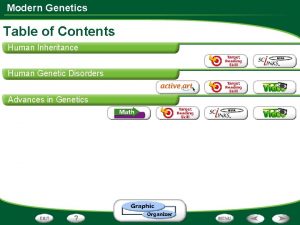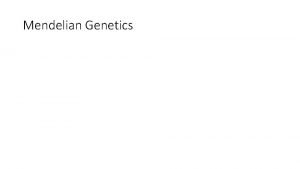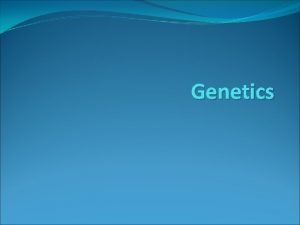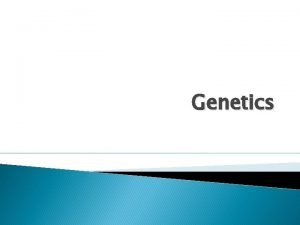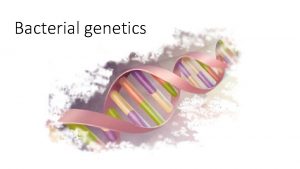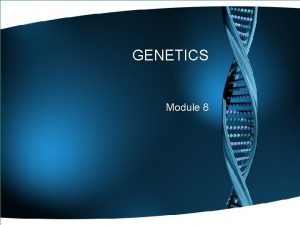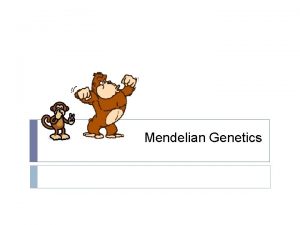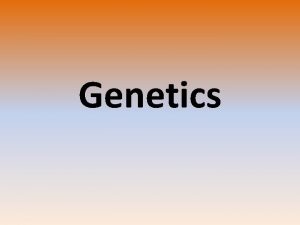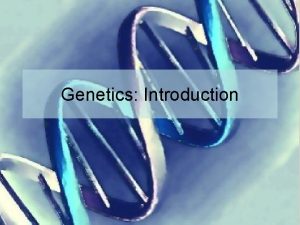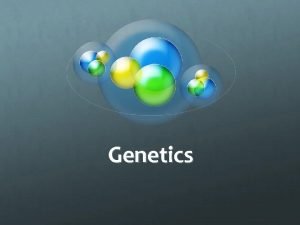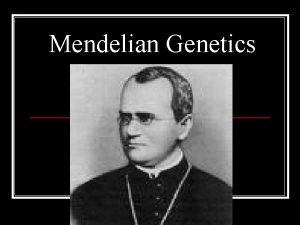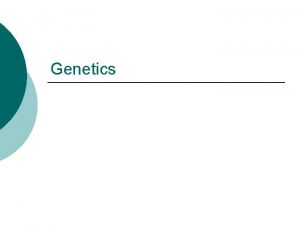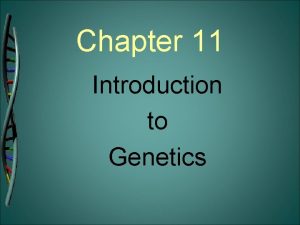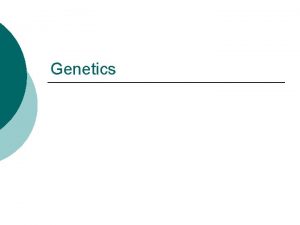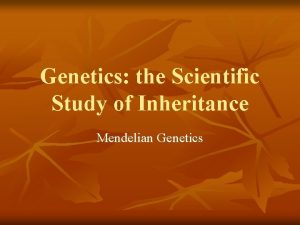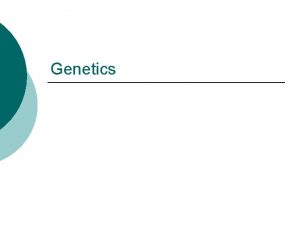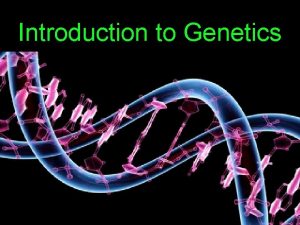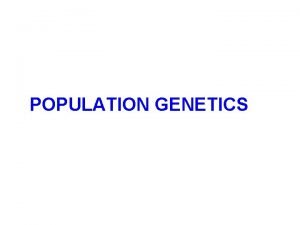Standard 4 Genetics Genetics The scientific study of























































































- Slides: 87

Standard 4

Genetics • Genetics = The scientific study of heredity how particular qualities or traits are transmitted from parents to offspring. • Genetics is the science of heredity and variation in living organisms. Knowledge that desired characteristics were inherited has been implicitly used since prehistoric times for improving crop plants and animals through selective breeding. However, the modern science of genetics, which seeks to understand the mechanisms of inheritance, only began with the work of Gregor Mendel in the mid-1800 s. An Introduction to Genetics and Heredity (00: 52)

Reproduction • Reproduction is necessary for genes to be passed on. • Reproduction is a characteristic for all living systems; being no individual organism lives forever, reproduction is essential to the continuation of every species. Some organisms reproduce asexually and other reproduce sexually. • Asexual reproduction = a type of reproduction where an organism replicates itself, by budding or dividing, without the involvement of other organisms. Mode of reproduction in which offspring arise from a single parent and inherit the genes of that parent only. Reproduction by cloning. • Sexual reproduction = production of new generations involving the exchange of chromosomes from both a male and female parent. Process in which two cells, termed gametes, come together to form one fertilized cell that contains genetic information from both parental cells.

Reproduction • The three main ways that asexual reproduction can take place are by fission, fragmentation, and regeneration. • In fission or budding, one or more individuals are formed from an original. These new clones can either remain attached physically to the parent or break away from it. Stony corals commonly exhibit this type of reproduction. Gemmules, a type of internal budding, allow an organism to survive under drastic conditions. Sponges exhibit this type of reproduction • Fragmentation is another way to reproduce asexually. The parent breaks into different fragments, which eventually form new individuals. This process is exemplified by certain flatworms known as planarians. Asexual reproduction through budding.

Asexual Reproduction • • • Advantages of Asexual Reproduction well-adapted genotypes can be preserved and multiplied root sprouts etc take advantage of already existing root system no fragile seedling stage good for harsh environments vigorous re-growth after disturbance Asexual reproduction can be very advantageous to certain animals. For instance, animals that remain in one particular place and are unable to look for mates would need to reproduce asexually. Another advantage of asexual reproduction is that numerous offspring can be produced without "costing" the parent a great amount of energy or time. Environments that are stable and experience very little change are the best places for organisms that reproduce asexually. The cloned offspring are more likely to succeed in the same stable areas as their parents. • Disadvantages of Asexual Reproduction • little variation to cope with fluctuating environment (high adaptation, but low adaptability) • root sprouts-- disease spreads from old to young individuals of clone susceptible for fast spread of epidemics

Sexual Reproduction • Advantages of sexual reproduction • Variety of progeny in the future • Seeds/fruits are formed- allows for effective long-distance dispersal • Disadvantages of sexual reproduction • Too much variation is a problem because it prevents close adaptation to any given environment • Seed germination and seedling stages are precarious due to high mortality rates in stressful environments Male Sperm Cell Attempting to Penetrate Female Egg

GENETICS • • • Gregor Mendel ( 1822 -1884) Austrian monk “Father of Genetics” Experimented with pea plants Used quantitative data analysis Gregor Mendel traced the inheritance patterns of certain traits in pea plants and showed that they could be described mathematically. Although not all features show these patterns of Mendelian inheritance, his work suggested the utility of the application of statistics to the study of inheritance.

GENETICS • Mendel observed that inheritance is fundamentally a discrete process with specific traits that are inherited in an independent manner. • These basic units of inheritance are now known as "genes". In the cells of organisms, genes exist physically in the structure of the molecule DNA and the information genes contain is used to create and control the components of cells. • Although genetics plays a large role in determining the appearance and behavior of organisms, it is the interaction of genetics with the environment an organism experiences that determines the ultimate outcome. For example, while genes play a role in determining a person's height, the nutrition and health that person experiences in childhood also have a large effect.

GENETICS • Pea Plant Characteristics: • • Round – Wrinkled Seed Short – Tall Green – Yellow Seed Purple – White Flower

GENETICS • Genetics = The study of heredity and how traits are passed on through generations. • Some traits are dominant – Dominant = An allele is said to be dominant if it expresses its phenotype even in the presence of a recessive allele. – Always represented with a capital letter: T = Tall T • Some traits are recessive – Recessive = A part of the gene that is only expressed if a dominant allele is not present – Always represented with a lower case letter: t = short t

GENETICS • Allele = a matched pair of genes for 1 characteristic – One allele is inherited from each parent T • • t Tt = a pair of alleles for 1 characteristic – plant height Rr = a pair of alleles for 1 characteristic – seed shape Gg = a pair of alleles for 1 characteristic – seed color Bb = a pair of alleles for 1 characteristic – flower color

GENETICS • To figure out which traits will be present you need to set up a Punnett Square, invented by RC Punnett. • Can show 2 types of crosses – monohybrid or dihybrid crosses. • In a monohybrid cross, organisms differing in only one trait are crossed. (Tt x Tt) or (AA x aa) or (Ss x Ss) • A dihybrid cross involves a study of inheritance patterns for organisms differing in two traits. Mendel invented the dihybrid cross to determine if different traits of pea plants, such as flower color and seed shape, were inherited independently. (see limousine cattle) Gregor Mendel's Rules of Heredity: Using Punnett Squares (05: 04) T T t t

• At its most fundamental level, inheritance in organisms occurs by means of discrete traits, called "genes". This property was first observed by Gregor Mendel, who studied the segregation of heritable traits in pea plants. In his experiments studying the trait for flower color, Mendel observed that the flowers of each pea plant were either purple or white — and never an intermediate between the two colors. These different, discrete versions of the same gene are called "alleles". GENETICS Chromosomes and the Work of Gregor Mendel (06: 06)

GENETICS • P 1 Generation = the first parents crossed • F 1 Generation = the first offspring • F 2 Generation = a cross between 2 F 1 parents T t t T Predicting the Resuts of a Cross Between a True Breeding Tall Plant and a True B (01: 01)

GENETICS • Phenotype = The physical expression of the genotype; an organism’s physical & observable characteristics. Literally means "the form that is shown"; it is the outward, physical appearance of a particular trait. • Mendel's pea plants exhibited the following phenotypes: – - round or wrinkled seed phenotype – - yellow or green seed phenotype – - purple or white flower phenotype – - tall or dwarf/short plant phenotype • Genotype = The genetic make-up of an individual organism. (Tt. Rr) • Purebred = an organism who, when mated with another purebred with the same characteristics, will always produce purebreds; genotypically, purebreds are homozygous. • Heterozygous = Having two different alleles of the same gene, one inherited from each parent. Tt, Rr, Aa, … • Homozygous = Having two identical alleles for a given trait, one inherited from each parent. TT, tt, RR, rr, AA, aa, …

GENETICS • Breeding cattle: • P 1 = Purebred x purebred white Phenotype: R R 100% all red r Rr Genotype: r Rr 100% Rr

GENETICS • Breeding cattle: • F 1 = Rr x Rr Phenotype: 3: 1 R r 75% red R RR Rr 25% white r Rr rr Genotype: 1: 2: 1 25% RR 50% Rr 25% rr

GENETICS • Incomplete Dominance = neither form of the gene is dominant • Shorthorn Cattle – R = Red – W = White – RW = Roan P 1 cross: RR x WW R R W RW Phenotype: 100% Roan Genotype: 100 % RW

GENETICS • Incomplete Dominance = neither form of the gene is dominant • Shorthorn Cattle – R = Red – W = White – RW = Roan Phenotype: 1: 2: 1 1 red F 1 Cross: RW x RW R W R RR RW 2 roan 1 white Genotype: 1: 2: 1 W RW WW 1 RR 2 RW 1 WW

GENETICS • Codominance • In codominance, neither phenotype is completely dominant. Instead, the heterozygous individual expresses both phenotypes. • A common example is the ABO blood group system. • The gene for blood types has three alleles: A, B, and i. • i causes O type and is recessive to both A and B. • The A and B alleles are co-dominant with each other. When a person has both A and B, they have type AB blood. A i B AB B i A O

GENETICS • Polygenic = A trait affected by many genes, no single gene has an over-riding influence. Any phenotype that results from the effect of multiple genes at two or more loci, with possible environmental influences too. Examples are: obesity, hypertension, hypercholesterolaemia, skin pigmentation, cancer, etc. • Some traits are determined by the combined effect of more than one pair of genes. These are referred to as polygenic, or continuous, traits. An example of this is human stature. The combined size of all of the body parts from head to foot determines the height of an individual. There is an additive effect. The sizes of all of these body parts are, in turn, determined by numerous genes. Human skin, hair, and eye color are also polygenic traits because they are influenced by more than one allele at different loci. The result is the perception of continuous gradation in the expression of these traits. Polygenic traits: stature, body shape, hair and skin color

GENETICS • Dihybrid Cross - Limousin Cattle - The history of Limousin cattle may very will be as old as the European continent itself. Cattle found in cave drawings estimated to be 20, 000 years old in the Lascaux Cave near Montignac, France, have a striking resemblance to today's Limousin These golden-red cattle are native to the south central part of France in the regions of Limousin and Marche. The terrain of the homeland has been described as rugged and rolling with rocky soil and a harsh climate. Consequently, the growing of field crops was very difficult at best and emphasis was placed on animal agriculture. Limousin cattle, as a result of their environment, evolved into a breed of unusual sturdiness, health and adaptability. • Limousin cattle: B = Black b = red • Polled (without horns): P = Polled p = horns

GENETICS • • Limousin cattle: B = Black b = red Polled (without horns): P = Polled p = horns Bb. Pp x Bb. Pp 4 possible gene combinations from each parent: BP Bp b. P bp BP BBPP BBPp Bb. PP Bb. Pp Phenotypic Ratio 9: 3: 3: 1 Bp BBPp BBpp Bb. Pp Bbpp Black Polled 9 b. P Bb. PP Bb. Pp bb. PP bb. Pp Black Horned 3 bp Bb. Pp Bbpp bb. Pp bbpp Red Polled 3 Red Horned 1

GENETICS • * Homework • Draw and label a homologous chromosome pair with heterozygous alleles highlighting a particular gene location.

GENETICS • * Homework • #1 Cross a heterozygous black polled bull with a homozygous red horned cow: • Bb. Pp x bbpp • #2 Cross a heterozygous black horned bull with a heterozygous black polled cow: • Bbpp x Bb. Pp

GENETICS • Males XY • Females XX • Sperm + Egg = Zygote = a 1 celled animal that grows by a process called MITOSIS

GENETICS • Diploid = (2 n) A full set of genetic material, consisting of paired chromosomes one chromosome from each parental set. Most animal cells except the gametes have a diploid set of chromosomes. The diploid human genome has 46 chromosomes. • Haploid = (1 n) A single set of chromosomes (half the full set of genetic material) present in the egg and sperm cells of animals and in the egg and pollen cells of plants. Human beings have 23 chromosomes in their reproductive cells.

GENETICS • PAIRS OF CHROMOSOMES IN LIVESTOCK & HUMANS: • Species # of Chromosomes Turkeys 41 Chickens 39 Horses 32 Cattle 30 Goats 30 Sheep 27 Humans 23 Swine 19

GENETICS • • • • Homo sapiens (human)46 Mus musculus (house mouse)40 Drosophila melanogaster (fruit fly)8 Caenorhabditis elegans (microscopic roundworm)12 Saccharomyces cerevisiae (budding yeast)32 Arabidopsis thaliana (plant in the mustard family)10 Xenopus laevis (South African clawed frog)36 Canis familiaris (domestic dog)78 Gallus gallus (chicken)78 Zea mays (corn or maize)20 Muntiacus reevesi (the Chinese muntjac, a deer)23 Muntiacus muntjac (its Indian cousin)6 Myrmecia pilosula (an ant)2 Parascaris equorum var. univalens (parasitic roundworm)2 Cambarus clarkii (a crayfish)200 Equisetum arvense (field horsetail, a plant)216

GENETICS • Mitosis = The process of dividing somatic cells (body cells) in which each daughter cell receives the same amount of DNA as the parent cell. • Purpose: Mitosis repairs body and allows for growth. • Mitosis has 6 steps: Interphase, Prophase, Metaphase, Anaphase, Telophase, and Cytokinesis. Mitosis (02: 20)

GENETICS • Interphase = “normal cell” • Cell grows • Most of the cell life is spent in this phase • Chromosomes double

GENETICS • Prophase = chromosomes become visible • Nuclear envelope breaks down • Spindle fibers appear

GENETICS • Metaphase = chromosomes line up at the equator • Spindle fibers attach to the centromere

GENETICS • Anaphase = chromatids separate • Chromatids are pulled to opposite poles

GENETICS • Telophase = chromosomes uncoil • Nuclear envelope reforms • Spindle fibers disappear

GENETICS • Cytokinesis = cytoplasm divides • 2 new cells

GENETICS • MITOSIS: • • • Body cells 1 division 2 cells produced Cells are diploid (2 n) Allows growth and repair Mitosis (02: 20)

GENETICS • MEIOSIS: • • • Sex cells 2 divisions 4 cells produced Cells are haploid (1 n) Allows for sexual reproduction

Meiosis 2 N 1 N Meiosis in the male and female divides each diploid cell into 4 haploid sex cells.

GENETICS • MEIOSIS: • Interphase 1 – Number of chromosomes doubles • Prophase 1 – – Nuclear membrane breaks Spindles appear Chromosomes become visible Homologous chromosomes line up next to each other = synapsis (AAaa) – Forms a tetrad = 4 homologous chromosomes – Crossing over = exchange of genes during Prophase 1, allows for genetic recombination

GENETICS • MEIOSIS: • Metaphase 1 – Homologous chromosomes line up at the equator

GENETICS • MEIOSIS: • Anaphase 1 – Homologous chromosomes separate and go to opposite poles

GENETICS • MEIOSIS: • Telophase 1 – Nuclear membrane forms – Spindle fibers disappear – Chromosomes become less visible • Cytokinesis 1 – Pinches into 2 cells

GENETICS • MEIOSIS: • Prophase 2 – Nuclear membrane breaks – Spindles appear – Chromosomes become visible

GENETICS • MEIOSIS: • Metaphase 2 – Sister chromosomes line up in the middle

GENETICS • MEIOSIS: • Anaphase 2 – Centromeres break and sister chromosomes separate to opposite poles

GENETICS • MEIOSIS: • Telophase 2 – Nuclear membranes reform – Spindles disappear • Cytokinesis 2 – Splits to make 4 haploid (1 n) cells Meiosis (02: 33)

Meiosis male sex cell production 2 N 2 N 1 N 1 N Haploid 2 N 1 N female sex cell production 2 N Diploid 2 N 2 N 1 N 1 N 1 N sperm 1 N egg 2 N Diploid Zygote Fertilization 1 N

GENETICS

GENETICS

Conclusion 1 N + 1 N = 2 N The haploid sperm nucleus may unite with the haploid egg nucleus resulting in a diploid zygote, and thus the cycle of life begins again.

GENETICS

GENETICS • MITOSIS: • MEIOSIS: • • • Body cells 1 division 2 cells produced Cells are diploid (2 n) Allows growth and repair Sex cells 2 divisions 4 cells produced Cells are haploid (1 n) Allows for reproduction


Mitosis The Big Picture somatic (body) cells 2 N Meiosis sex cells (sperm or egg) 2 N 2 N = Diploid 1 N = Haploid 2 N 2 N 2 N 1 N 1 N 2 N Diploid 1 N

GENETICS • Chromosomes = Part of a cell that contains genetic information. • Genes = small bits of heredity information; genes are composed of DNA and are carried on the chromosomes. • DNA = deoxyribonucleic acid, the molecule that holds genetic information. It is the biochemical molecule that makes chromosomes and genes. • Relationship between DNA – chromosomes – genes? – DNA is the concrete, Chromosomes are the wall, Genes are individual blocks. DNA Molecule: DNA Unzip 1: 16

GENETICS • DNA = deoxyribonucleic acid • Found in the nuclei of cells – there is 46 chromosomes in each human cell nuclei • If the DNA in all 46 human chromosomes in 1 cell were uncoiled it would stretch out to be more than 6 feet in length • Crick and Watson worked out the structure of DNA = double helix • Contains all your traits (genes) and makes up chromosomes • Thousands of genes are contained on each DNA molecule DNA: Deoxyribonucleic Acid (02: 02)

GENETICS • • DNA = deoxyribonucleic acid The vertical sides of DNA are made up of sugar and phosphate Cross pieces are nucleotide bases: A-T C-G Genetic traits are determined by the order of the DNA nucleotide bases A T C G • DNA makes a copy of itself = replication

GENETICS • Two different kinds of genetic material exist: deoxyribonucleic acid (DNA) and ribonucleic acid (RNA). • Most organisms are made of DNA, but a few viruses have RNA as their genetic material. The biological information contained in an organism is encoded in its DNA or RNA sequence. • Interestingly, as much as 98% of human DNA does not code for a specific product. • Prokaryotic genetic material is organized in a simple circular structure that rests in the cytoplasm. • Eukaryotic genetic material is more complex and is divided into discrete units called genes. Genes (02: 17)

GENETICS • The information passed from parents to offspring is transmitted by means of genes that are coded in DNA molecules. These genes contain the information for the production of proteins. • Genes express their functional effect through the production of proteins, which are complex molecules responsible for most functions in the cell. Proteins are chains of amino acids, and the DNA sequence of a gene (through an RNA intermediate) is used to produce a specific protein sequence. • Each group of three nucleotides in the sequence, called a codon, corresponds to one of the twenty possibly amino acids in protein — this correspondence is called the genetic code. The specific sequence of amino acids results in a unique three-dimensional structure for that protein, thereby determining its behavior and function.

GENETICS • The molecular basis for genes is deoxyribonucleic acid (DNA). DNA is composed of a chain of nucleotides, of which there are four types: adenine (A), cytosine (C), guanine (G), and thymine (T). Genetic information exists in the sequence of these nucleotides, and genes exist as stretches of sequence along the DNA chain. The genetic code: DNA, through a messenger RNA intermediate, codes for protein with a triplet code.

GENETICS • Nucleotide = Basic building block of DNA and RNA. A nucleotide is made of a ribose sugar, nitrogenous base, and phosphate group. • 4 Bases: Adenene, Guanine, Cytosine, Thyamine → A-T C-G • The nucleotides join together to form a chain. The phosphate end of the chain is referred to as the 5’ end. The opposite end is the 3' end.

GENETICS • Replication = The process of making an identical copy of a section of duplex (double-stranded) DNA, using existing DNA as a template for the synthesis of new DNA strands • Transcription = Transcription is the process through which a DNA sequence is enzymatically copied by an RNA polymerase to produce a complementary RNA. In the case of protein-encoding DNA, transcription is the beginning of the process that ultimately leads to the translation of the genetic code (via the m. RNA intermediate) into a functional peptide or protein. • Translation = The process of turning instructions from m. RNA, base by base, into chains of amino acids that then fold into proteins. Introduction: Transcription of DNA to Messenger RNA (02: 24)

Mendel’s Laws Investigating Mendel's Law of Segregation (04: 41) • Mendel's First Law of Genetics is The Law of Segregation, essentially has 4 parts: – 1. Alternative versions of genes account for variations in inherited characteristics. This is the concept of alleles. Alleles are different versions of genes that impart the same characteristic. For example, each human has a gene that controls eye color, but there are variations among these genes in accordance with the specific color the gene "codes" for. – 2. For each characteristic, an organism inherits two alleles, one from each parent. This means that when somatic cells are produced from two gametes, one allele comes from the mother and one from the father. – 3. If the two alleles differ, then one, the allele that encodes the dominant trait, is fully expressed in the organism's appearance; the other, the allele encoding the recessive trait, has no noticeable effect on the organism's appearance. In other words, only the dominant trait is seen in the phenotype of the organism. This allows recessive traits to be passed on to offspring even if they are not expressed. Not all traits have a dominant-recessive relationship, however. Exceptions include incomplete dominance and codominance. – 4. The two alleles for each characteristic segregate during gamete production. This means that each gamete will contain only one allele for each gene. This allows the maternal and paternal alleles to be combined in the offspring, ensuring variation.

Mendel’s Laws • Law of Independent Assortment = during gamete formation the segregation of the alleles of one allelic pair is independent of the segregation of the alleles of another allelic pair. • The Law of Independent Assortment, also known as "Inheritance Law" or Mendel's Second Law, states that the emergence of one trait will not affect the emergence of another. • Mendel concluded that different traits are inherited independently of each other, so that there is no relation, for example, between a cat's color and tail length.

GENETICS Identical Genes: The Science of Identical Twins (02: 13) • TWINS: • Identical Twins = (monozygotic) result when a single fertilized egg splits after conception. The resulting twins are the same sex and genetically alike, with similar foot and hand prints, but different fingerprints and teeth marks. The egg then splits into two genetically identical halves. They share 100% of their genes. • 1 egg and 1 sperm • Fraternal Twins = (dizygotic) result when two eggs are released by the mother at the same time and each egg is fertilized by a different sperm. Fraternal twins can be of the same or opposite sex. They share up to 50% of their genes, and are no more alike or different than any two siblings would be, but their bond is just as special. • 2 eggs and 2 sperm

GENETICS • Sex-linked = If a gene is found only on the X chromosome and not the Y chromosome, it is said to be a sex-linked trait. Because the gene controlling the trait is located on the sex chromosome, sex linkage is linked to the gender of the individual. Usually such genes are found on the X chromosome. The Y chromosome is thus missing such genes (See Diagram above. ). The result is that females will have two copies of the sex-linked gene while males will only have one copy of this gene. If the gene is recessive, then males only need one such recessive gene to have a sex-linked trait rather than the customary two recessive genes for traits that are not sex-linked. This is why males exhibit some traits more frequently than females. Examples of Sex-linked Traits: Red-green colorblindness Male Pattern Baldness Hemophilia Duchenne Muscular Dystrophy

Genetic Variation • Mendelian Genetics can only account for a majority of the genetic variations in species seen on earth. Other sources of Genetic Variation include Chromosomes Crossing over, Mutations, and Genetic Drift. • Crossing Over • How do you get a chromosome that is totally different from the original chromosomes of both parents? Crossing-Over takes place during Meiosis. During the process, DNA lengths are shared between chromosomes. In the illustration at left, two chromosomes intertwine, and exchange one end of the chromosome with the other. The end Chromosome has a completely different chemical composition from the starting two chromosomes.

Genetic Variation • Mutations • Mutation takes place when an organism undergoes a spontaneous genetic change during replication. During the process of replication, the nucleotides of a chromosome are altered, so rather than creating an identical copy of DNA strands, there are chemical variations in the replicated strands. The alteration on the chemical composition of DNA triggers a chain reaction in the genetic information of an individual. The mutation can be passed to offspring. For example, the mutation toward sickle cell anemia is based upon the production of one different amino acid, which in turn affects the polypeptide strands produced, etc. Mutations are usually non-beneficial to an organism, however, they are almost always recessive and unless two mutations are coupled together the mutation will not be expressed. • * Predict how mutations may be transferred to progeny (offspring)

Genetic Variation Mutations (02: 03) • Mutations … • Gene mutation in a cell can result in uncontrolled cell division called cancer. • Also, exposure of cells to certain chemicals and radiation increases mutations and thus increases the chance of cancer. Basal Cell Carcinoma of the Nose

Genetic Variation • Genetic Drift • Gene flow refers to the passage of traits or genes between populations. The passage of genes from one population to another prevents high occurrences of mutation, and genetic drift. In genetic drift, random variation occurs because the genetic population is small, leading to the proliferation of specific traits within a population. For example, the population in the colonial history of Martha's Vineyard, settled in Massachusetts in 1642, had an unusually high occurrence of deafness among it's inhabitants. The high occurrence of deafness was a result of genetic drift, in that the population was so small that differing traits from outside populations could not enter in. To prevent genetic drift, genetic material must be shared between differing populations, even so, variations can occur. For example, the trait for sickle cell anemia is beneficial in some climates where there is a high rate of malaria. An individual with a heterozygous genotype for sickle cell anemia is more resistant to malaria. The concept of gene flow consequently ties directly into the concept of adaptation and natural selection.

Mutations • A mutation is a permanent change in the DNA sequence of a gene. Mutations in a gene's DNA sequence can alter the amino acid sequence of the protein encoded by the gene. How does this happen? Like words in a sentence, the DNA sequence of each gene determines the amino acid sequence for the protein it encodes. The DNA sequence is interpreted in groups of three nucleotide bases, called codons. Each codon specifies a single amino acid in a protein. • • Types of mutations: Original: The fat cat ate the wee rat. Point Mutation: The fat hat ate the wee rat. Frame Shift: The fat caa tet hew eer at. Deletion: The fat ate the wee rat. Insertion: The fat cat xlw ate the wee rat. Inversion: The fat tar eew eht eta tac.

Mutations • Mutate a sentence! • We can think about the DNA sequence of a gene as a sentence made up entirely of three-letter words. In the sequence, each three-letter word is a codon, specifying a single amino acid in a protein. Have a look at this sentence: • Thesunwashotbuttheoldmandidnotgethishat. • If you were to split this sentence into individual three-letter words, you would probably read it like this: • The sun was hot but the old man did not get his hat. • This sentence represents a gene. Each letter corresponds to a nucleotide base, and each word represents a codon. What if you shifted the three-letter "reading frame? " You would end up with this: • T hes unw ash otb utt heo ldm and idn otg eth ish at. • Or • Th esu nwa sho tbu tth eol dma ndi dno tge thi sha t.

Mutations • As you can see, only one of these three "reading frames" translates into an understandable sentence. In the same way, only one three-letter reading frame within a gene codes for the correct protein. • Now, going back to the original sentence: • Thesunwashotbuttheoldmandidnotgethishat. • See how you can mutate the reading frame of this sentence by inserting or deleting letters within the sentence. • It's easy to make mutations that create "nonsense" sentences. Can you make mutations that maintain or change the meaning of the sentence without creating such nonsense?

Mutations

Mutations I have been told that due to pestacide use that some tree frogs in the southern US have been having pigment mutation and turning blue.

Mutations

Mutations Natural Selection and Mutation The Case of the Peppered Moth This poor little rascal knows what it's like to have part of his genome deleted

Mutations Six Legged Calf Walking Two Legged Dog Two Headed Turtle

Mutations Frog and a Half Eight Legged Cat

Genetic Variation • Jumping Genes = Transposons are sequences of DNA that can move around to different positions within the genome of a single cell, a process called Transposition. In the process, they can cause mutations and change the amount of DNA in the genome. Transposons are also called "jumping genes" or "mobile genetic elements". There a variety of mobile genetic elements, they can be grouped based on their mechanism of transposition. • Deletion = when a part of a chromosome is missing, or part of the DNA code is missing, in the process of DNA replication, a deletion occurs if a nucleotide or series of nucleotides is not copied. Such deletions may be harmless, may result in disease, or may in rare cases be beneficial. • Duplication = A double copy of part of a chromosome resulting in an extra (abnormal) dose of the duplicated material, or when a part of a chromosome is present in two copies.

Genetic Variation • It may be possible to identify genetic defects from a karyotype of a few cells. • Karyotype = A picture of the chromosomes in a cell that is used to check for abnormalities. A karyotype is created by staining the chromosomes with dye and photographing them through a microscope. The photograph is then cut up and rearranged so that the chromosomes are lined up into corresponding pairs. This is an example of trisomy 21 (47, XY, +21) also known as Down syndrome. Additions or deletions of genetic material are generally lethal in utero, but Trisomy 21 is an example of one form of addition in which the fetus may occasionally survive to term and beyond. The overall incidence is 1 in 1000 livebirths, but the nondysjunctional event in meiosis that produces this anomaly increases in incidence with increasing maternal age, particularly over age 40.

Genetic Engineering -Genetic engineering techniques provide great potential and responsibilities. -Genetic engineering, recombinant DNA technology, genetic modification/manipulation (GM) and gene splicing are terms that are applied to the manipulation of genes, implying that the process is outside the organism's natural reproductive process. It involves the isolation, manipulation and reintroduction of DNA into cells or model organisms, to express a protein. -The aim is to introduce new characteristics or attributes physiologically or physically, such as making a crop resistant to herbicide, introducing a novel trait or enhancing existing ones, or producing a new protein or enzyme. -Successful endeavors include the manufacture of human insulin by bacteria, the manufacture of erythropoietin in Chinese hamster ovary cells, the production of new types of experimental mice such as the Onco. Mouse (cancer mouse) for research, and round up ready crops.

Genetic Engineering - Roundup Ready Corn and Soybeans - All plants make proteins. Roundup Ready plants produce the same natural proteins as any other plant with one notable exception. These plants make an additional protein which allows them to grow in the presence of Glyphosate, known commercially as “Roundup, ” one of the most widely-used herbicides employed by back-yard gardeners, homeowners, golf courses and commercial farms for the past 25 years. The protein is not a toxin to plants, animals, insects, humans or bacteria. Transgenics: Splicing Genes Across Species (03: 19)

Cloning Debate (37 -3 / Debate) Pros of Cloning: + + + + + + + + • If the vital organs of the human body can be cloned, they can serve as backup systems for human beings. Cloning body parts can serve as a lifesaver. When a body organ such as a kidney or heart fails to function, it may be possible to replace it with the cloned body organ. • Cloning in human beings can prove to be a solution to infertility. Cloning has the potential of serving as an option for producing children. Cloning may make it possible to reproduce a certain trait in human beings. We will be able to produce people with certain qualities, human beings with particular desirable traits, thus making human beings a man-made being! • Cloning technologies can prove helpful for the researchers in genetics. They might be able to understand the composition of genes and the effects of genetic constituents on human traits, in a better manner. They will be able to alter genetic constituents in cloned human beings, thus simplifying their analysis of genes. Cloning may also help us combat a wide range of genetic diseases. • Cloning can make it possible for us to obtain customized organisms and harness them for health benefits of society. Cloning can serve as the best means to replicate animals that can be used for research purposes. • Cloning can enable the genetic alteration of plants and animals. If positive changes can be brought about in living beings with the help of cloning, it will indeed be a boon to mankind.

Cloning Debate (37 -3 / Debate) Cons of Cloning: - - - - - - - - - - - • Cloning created identical genes. It is a process of replicating a genetic constitution, thus hampering the diversity in genes. While lessening the diversity in genes, we weaken our ability of adaptation. Cloning is also detrimental to the beauty that lies in diversity. • While cloning allows man to tamper with genetics in human beings, it also makes deliberate reproduction of undesirable traits, a probability. Cloning of body organs might invite malpractices in society. • In cloning human organs and using them for transplant, or in cloning human beings themselves, technical and economic barriers will have to be considered. Will cloned organs be cost-effective? Will cloning techniques really reach the common man? • Moreover, cloning will put human and animal rights at stake. Will cloning fit into our ethical and moral principles? Cloning will leave man just another man-made being. Won't it devalue mankind? Won't it undermine the value of human life? • Cloning is equal to emulating God. Is that easy? Is that risk-free? Many are afraid it is not!

Genetic Engineering • What are the advantages and disadvantages of human manipulation of DNA? … • Debate Video Quiz: Genetics: The Molecular Basis of Heredity (01: 14)
 Scientific inquiry vs scientific method
Scientific inquiry vs scientific method How is a scientific law different from a scientific theory?
How is a scientific law different from a scientific theory? Genes is the study of heredity and variation
Genes is the study of heredity and variation Chapter 7 extending mendelian genetics answer key
Chapter 7 extending mendelian genetics answer key Scientific notation
Scientific notation Standard notation
Standard notation Linguistics as a scientific study of language
Linguistics as a scientific study of language Social psychology is the scientific study of
Social psychology is the scientific study of Sociology major
Sociology major India baby tossing
India baby tossing The scientific study of trees
The scientific study of trees The scientific study of behavior and mental processes
The scientific study of behavior and mental processes Finished files are the result of
Finished files are the result of What is ergonomics
What is ergonomics The scientific study of heredity *
The scientific study of heredity * Hình ảnh bộ gõ cơ thể búng tay
Hình ảnh bộ gõ cơ thể búng tay Ng-html
Ng-html Bổ thể
Bổ thể Tỉ lệ cơ thể trẻ em
Tỉ lệ cơ thể trẻ em Voi kéo gỗ như thế nào
Voi kéo gỗ như thế nào Thang điểm glasgow
Thang điểm glasgow Hát lên người ơi
Hát lên người ơi Môn thể thao bắt đầu bằng chữ f
Môn thể thao bắt đầu bằng chữ f Thế nào là hệ số cao nhất
Thế nào là hệ số cao nhất Các châu lục và đại dương trên thế giới
Các châu lục và đại dương trên thế giới Công của trọng lực
Công của trọng lực Trời xanh đây là của chúng ta thể thơ
Trời xanh đây là của chúng ta thể thơ Cách giải mật thư tọa độ
Cách giải mật thư tọa độ Làm thế nào để 102-1=99
Làm thế nào để 102-1=99 Phản ứng thế ankan
Phản ứng thế ankan Các châu lục và đại dương trên thế giới
Các châu lục và đại dương trên thế giới Thơ thất ngôn tứ tuyệt đường luật
Thơ thất ngôn tứ tuyệt đường luật Quá trình desamine hóa có thể tạo ra
Quá trình desamine hóa có thể tạo ra Một số thể thơ truyền thống
Một số thể thơ truyền thống Bàn tay mà dây bẩn
Bàn tay mà dây bẩn Vẽ hình chiếu vuông góc của vật thể sau
Vẽ hình chiếu vuông góc của vật thể sau Biện pháp chống mỏi cơ
Biện pháp chống mỏi cơ đặc điểm cơ thể của người tối cổ
đặc điểm cơ thể của người tối cổ V. c c
V. c c Vẽ hình chiếu đứng bằng cạnh của vật thể
Vẽ hình chiếu đứng bằng cạnh của vật thể Tia chieu sa te
Tia chieu sa te Thẻ vin
Thẻ vin đại từ thay thế
đại từ thay thế điện thế nghỉ
điện thế nghỉ Tư thế ngồi viết
Tư thế ngồi viết Diễn thế sinh thái là
Diễn thế sinh thái là Dạng đột biến một nhiễm là
Dạng đột biến một nhiễm là Số.nguyên tố
Số.nguyên tố Tư thế ngồi viết
Tư thế ngồi viết Lời thề hippocrates
Lời thề hippocrates Thiếu nhi thế giới liên hoan
Thiếu nhi thế giới liên hoan ưu thế lai là gì
ưu thế lai là gì Sự nuôi và dạy con của hổ
Sự nuôi và dạy con của hổ Khi nào hổ mẹ dạy hổ con săn mồi
Khi nào hổ mẹ dạy hổ con săn mồi Hệ hô hấp
Hệ hô hấp Từ ngữ thể hiện lòng nhân hậu
Từ ngữ thể hiện lòng nhân hậu Thế nào là mạng điện lắp đặt kiểu nổi
Thế nào là mạng điện lắp đặt kiểu nổi Std error
Std error Standard language vs home language
Standard language vs home language What is the standard price
What is the standard price Peruntukan waktu kssm pendidikan khas
Peruntukan waktu kssm pendidikan khas Gold standard study
Gold standard study Ecological study vs cohort study
Ecological study vs cohort study Retrospective cohort study vs prospective cohort study
Retrospective cohort study vs prospective cohort study Critical examination in method study
Critical examination in method study Marty lobdel
Marty lobdel Phytogeographical regions of india map
Phytogeographical regions of india map Work study objectives
Work study objectives Time and motion study example ppt
Time and motion study example ppt Yellow and blue make what
Yellow and blue make what Earwax type genetics
Earwax type genetics Sponge susie roundpants
Sponge susie roundpants Silkie chicken color genetics
Silkie chicken color genetics Sexual reproduction and genetics section 1 meiosis
Sexual reproduction and genetics section 1 meiosis Forward genetics
Forward genetics Genetics model
Genetics model Parent offspring regression
Parent offspring regression Probability in genetics
Probability in genetics Learn.genetics.utah/content/addiction/mouse
Learn.genetics.utah/content/addiction/mouse Linkage disequilibrium definition
Linkage disequilibrium definition Allelic frequencies
Allelic frequencies Trihybrid cross branch diagram
Trihybrid cross branch diagram Blood pedigree
Blood pedigree Codominance
Codominance Http://learn.genetics.utah.edu/content/addiction/
Http://learn.genetics.utah.edu/content/addiction/ Http://learn.genetics.utah.edu/content/addiction/
Http://learn.genetics.utah.edu/content/addiction/ Blood type genetics
Blood type genetics Human inheritance modern genetics answer key
Human inheritance modern genetics answer key




